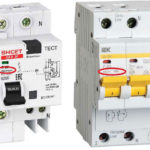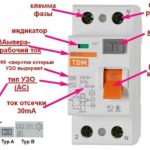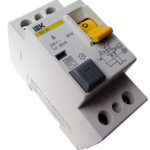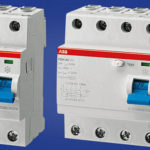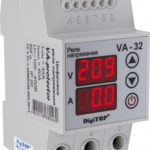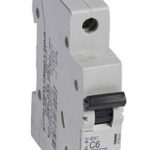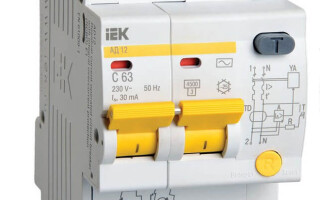Residual current circuit breaker - a unique device that combines in a single body the functions of two protective devices - it is simultaneously RCD and circuit breaker. Professionals recommend the use of differential circuit breakers on a mandatory basis when installing or reconstructing wiring.
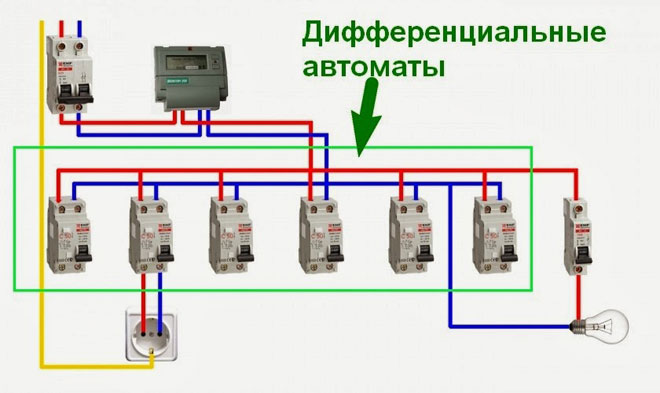
What is the purpose of differential circuit breakers, according to what parameters is selected and what is its connection scheme - the answers to these questions we will try to give below.
Contents
What are RCCBs for?
The express purpose of the automatic differential is to protect people from electric shock in case of direct contact. The device simultaneously monitors both the occurrence of short-circuitand the appearance of signs of electricity leakage through damaged conductive network components.
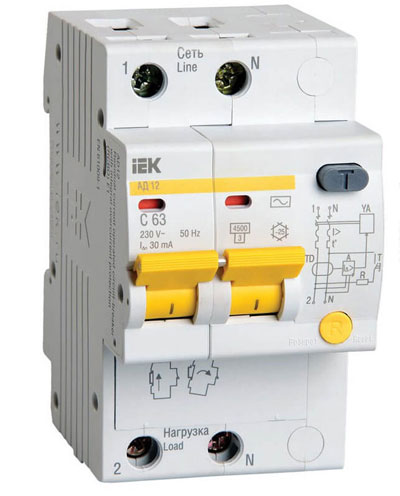
The RCCB will de-energize the monitored line if a short circuit occurs:
- short circuit;
- Overheating of the electrical wiring due to exceeding the rated current setting of the residual current device;
- leakage to earth more than the corresponding setting.
Thus, a simple device is quite capable of securing an apartment or private home, preventing the occurrence of emergencies caused by problems with electricity.
The advantage of using a differential circuit breaker is that there is no need to selection of RCDbecause it is already contained in the components of the differential circuit breaker. A single device which combines the functions of the two (RCD and circuit breaker), takes up less space in an electrical panel on the size of a single-pole circuit breaker - its width of 17.5 mm.
Among the disadvantages we can highlight the likelihood of failure of one of the two components of the automatic circuit breaker - replacement of a separate part is impossible, which will have to buy a new automatic differential.
Technical device
The switch-disconnectors are made of dielectric material. The rear part has a special attachment for mounting on DIN rail. Inside, they consist of a two-pole or four-pole circuit breaker and a differential protection module in series with it. This module is a differential current transformer, through which the zero and the phase pass, thus forming the primary winding and the control winding - the secondary winding.
How a differential circuit breaker works
At the heart of the principle of the automatic differential is the use of a special transformer, the functioning of which is based on changes in the differential current in the conductors of electricity.
When leakage currents occur, the balance is disturbed, because part of the current does not return. The phase and neutral conductors start to produce different magnetic fluxes and a differential magnetic flux occurs in the core of the current transformer. This results in a current in the control windings and triggers the release.
When the circuit breaker module overheats, a bimetallic plate triggers and opens the circuit breaker.
Main features
Each automatic circuit breaker has eight terminals for three-phase and four for single-phase. The device itself is modular and consists of:
- A housing made of non-flammable refractory material;
- Terminals with markings designed to connect the conductors;
- An on/off lever. The number depends on the model of the particular device;
- The test button, allowing you to manually test the functionality of the differential automaton;
- A signal light to indicate the type of tripping (leakage or overload).
When selecting a automatic differential switch, all relevant information can be found directly on the case of the device.
The choice of a residual current device should be made on the basis of many parameters:
- The rated current - indicates the load for which the circuit breaker is designed. These values are standardized and can take the following values: 6, 10, 16, 20, 25, 32, 40, 50, 63А.
- Time-current characteristics - values can be B, C and D. For a simple network with low-power equipment (used rarely) will do type B, in a city apartment - C, at powerful manufacturing plants - D. For example, when starting an engine, the current increases sharply for a fraction of a second, because some effort is needed to unwind it. This starting current can be several times higher than the rated current. After start-up, the current consumption is several times less. This is what this parameter is for. The characteristic B means a short-term excess of this starting current of 3-5 times, C - 5-10 times, D - 10-20 times.
- The differential leakage current – 10 or 30 mA. The first type is suitable for a line with 1-2 consumers, the second - with several consumers.
- Class of differential protection - determines what kind of leaks will respond to the circuit breaker. When selecting a device for an apartment, classes AC or A are suitable.
- Breaking capacity - The value depends on the rating of the circuit breaker and should be above 3 kA for circuit breakers up to 25 A, 6 kA for circuit breakers up to 63 A and 10 kA for circuit breakers up to 125 A.
- Current limiting class - indicates how quickly a line will shut down if critical currents occur. There are 3 classes of circuit breakers, from the slowest, 1, to the fastest, 3, respectively, in terms of tripping. The higher the class, the higher the price.
- The conditions of use - Are determined on the basis of need.
Choosing a circuit breaker by wattage
In order to select the circuit breaker rating, you must consider the condition of the wiring. Provided the wiring is of good quality, reliable and meets all requirements, the following formula can be used to calculate the rating I=P/Uwhere P is the total power of the electric appliances used on the automatic differential switch line. Select the circuit breaker with the closest rating. Below is a table of rating of differential on the load power for the network 220 V.
Caution! The electrical conductors must be correctly sized for the load rating.
All the characteristics of the differential is specified directly on the body of the device, which will facilitate the selection of a suitable differential automatic device and help you decide what automatic circuit breaker for the apartment will be suitable for the best.
| Power | Cable | Fuse breaker |
|---|---|---|
| up to 2 kW | VVGngLS 3x1.5 | С10 |
| From 2 to 3 kW | VVGngLS 3õ2.5 | С16 |
| 3 to 5 kW | VVGngLS 3õ4 | С25 |
| 5 to 6.3 kW | VVGngLS 3x6 | С32 |
| 6.3 to 7.8 kW | VVGngLS 3х6 | С40 |
| 7.8 to 10 kW | VVGngLS 3x10 | С50 |
Currently on sale are difavtomats with two types of release:
- Electronic - Has an electronic circuit with a signal amplifier, which is powered from the connected phase, which makes the device vulnerable in the absence of power. If there is a zero loss, it will not trip.
- Electromechanical - Will not require external power sources for operation, making it self-contained.
Connecting
Connecting the differential is a very simple process. The upper part of the automatic differential switch has contact plates and terminal screws designed to connect the N-zero and L-phase from the meter. The lower part has the contacts, to which the line with the consumers is connected.
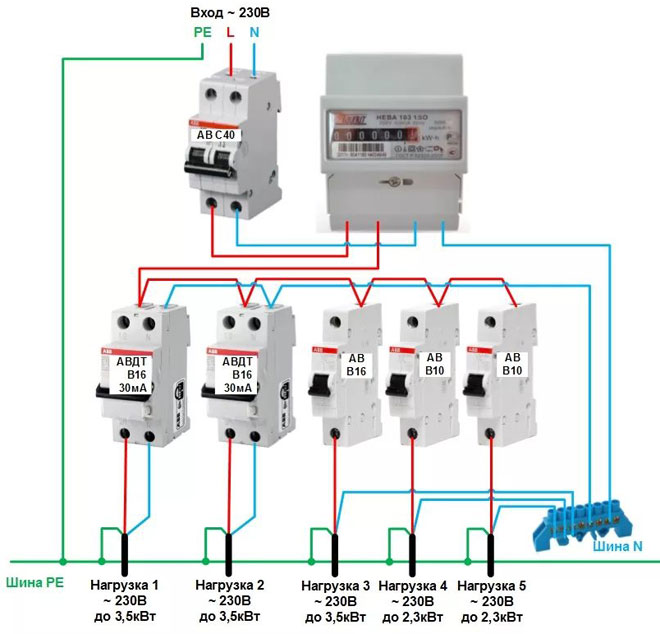
Connection of the automatic disconnector can be represented as follows:
- Stripping the ends of the conductors from the insulating material by about 1 centimeter.
- Loosen the clamping screw a few turns.
- Connecting the conductor.
- Tightening the screw.
- Checking the quality of attachment with a simple physical force.
Choice of configuration RCD + automatic circuit breaker and conventional disconnector should be conditioned by the availability of space in the switchboard and the price of the devices themselves. In the first case, the complexity of installation will increase slightly.
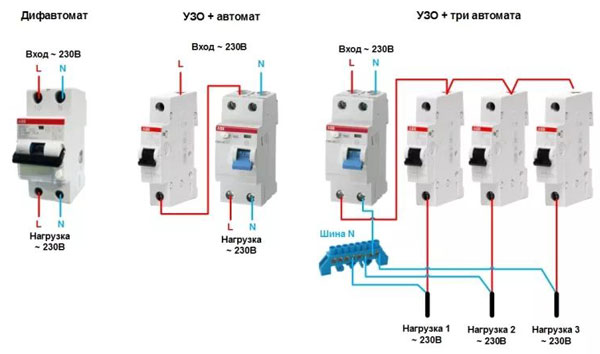
In the case of a single-phase network of 220 V, which is used in most apartments and houses, you need to use a two-pole device. Installation of a differential circuit breaker in this case can be carried out in two ways:
- At the inlet after the electric meter for all apartment wiring. When using this circuit, the supply wires are connected to the upper terminals. To the lower terminals, the load is supplied by the various electrical groups separated by circuit breakers. A significant disadvantage of this option is the difficulty to find the cause of failure in the case of automatic operation and complete disconnection of all groups in case of malfunction.
- For each group of consumers separately. This method is used to protect rooms with high levels of humidity - bathrooms, kitchens. This method is also relevant for places where electrical safety must be at the highest level - for example, for children. You will need several differential circuit breakers - despite the high costs, this method is the most reliable and guarantees an uninterrupted power supply, and the tripping of any of the differential circuit breakers will not make the others work.
If you have a three-phase network of 380 V, you need to use a four-pole circuit breaker. This option is used in new houses or cottages, where the device needs to withstand high loads from electrical appliances. It is possible to use such a connection of differential circuit breakers in garages due to the possible use of powerful electrical equipment.
It can be concluded that the connection diagram of differential circuit breakers is not much different from similar schemes for RCDs. At the output of the device should be connected phase and zero of the protected section of the network. The safety of this group will be monitored.
Differential circuit breakers are successfully used in both single-phase and three-phase AC networks. The installation of such a device significantly increases the level of safety in the operation of electrical appliances. In addition, the differential circuit breaker can contribute to the prevention of fire associated with the ignition of insulating material.
Related articles:
